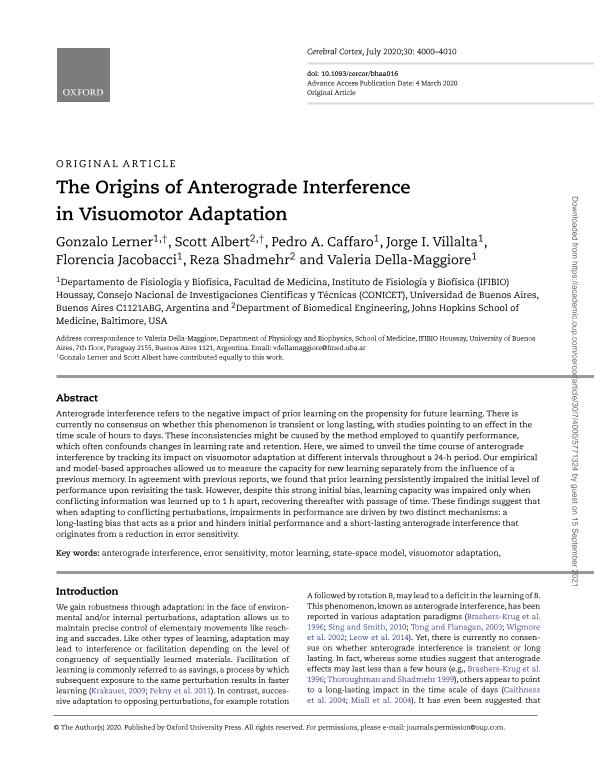Artículo
The origins of anterograde interference in visuomotor adaptation
Lerner, Gonzalo; Albert, Scott; Caffaro, Pedro Alejandro ; Villalta, Jorge Ignacio
; Villalta, Jorge Ignacio ; Jacobacci, Florencia
; Jacobacci, Florencia ; Shadmehr, Reza; Della Maggiore, Valeria Monica
; Shadmehr, Reza; Della Maggiore, Valeria Monica
 ; Villalta, Jorge Ignacio
; Villalta, Jorge Ignacio ; Jacobacci, Florencia
; Jacobacci, Florencia ; Shadmehr, Reza; Della Maggiore, Valeria Monica
; Shadmehr, Reza; Della Maggiore, Valeria Monica
Fecha de publicación:
03/2020
Editorial:
Oxford Univ Press Inc
Revista:
Cerebral Cortex
ISSN:
1047-3211
Idioma:
Inglés
Tipo de recurso:
Artículo publicado
Clasificación temática:
Resumen
Anterograde interference refers to the negative impact of prior learning on the propensity for future learning. There is currently no consensus on whether this phenomenon is transient or long lasting, with studies pointing to an effect in the time scale of hours to days. These inconsistencies might be caused by the method employed to quantify performance, which often confounds changes in learning rate and retention. Here, we aimed to unveil the time course of anterograde interference by tracking its impact on visuomotor adaptation at different intervals throughout a 24-h period. Our empirical and model-based approaches allowed us to measure the capacity for new learning separately from the influence of a previous memory. In agreement with previous reports, we found that prior learning persistently impaired the initial level of performance upon revisiting the task. However, despite this strong initial bias, learning capacity was impaired only when conflicting information was learned up to 1 h apart, recovering thereafter with passage of time. These findings suggest that when adapting to conflicting perturbations, impairments in performance are driven by two distinct mechanisms: a long-lasting bias that acts as a prior and hinders initial performance and a short-lasting anterograde interference that originates from a reduction in error sensitivity.
Archivos asociados
Licencia
Identificadores
Colecciones
Articulos(IFIBIO HOUSSAY)
Articulos de INSTITUTO DE FISIOLOGIA Y BIOFISICA BERNARDO HOUSSAY
Articulos de INSTITUTO DE FISIOLOGIA Y BIOFISICA BERNARDO HOUSSAY
Citación
Lerner, Gonzalo; Albert, Scott; Caffaro, Pedro Alejandro; Villalta, Jorge Ignacio; Jacobacci, Florencia; et al.; The origins of anterograde interference in visuomotor adaptation; Oxford Univ Press Inc; Cerebral Cortex; 30; 7; 3-2020; 4000-4010
Compartir
Altmétricas



